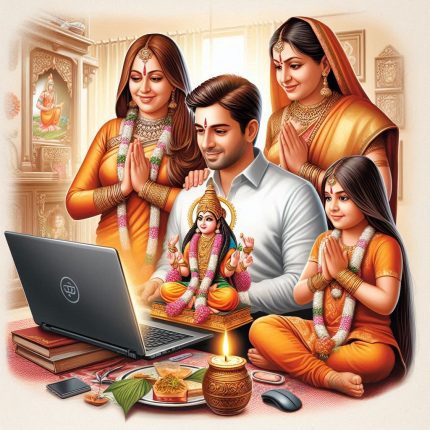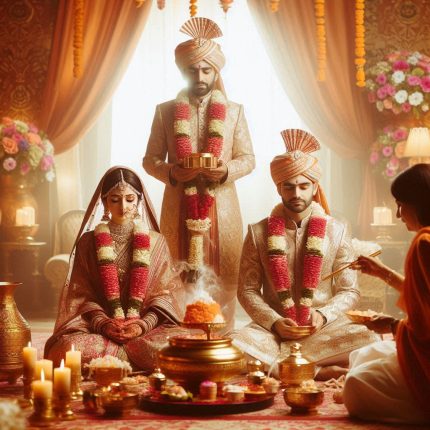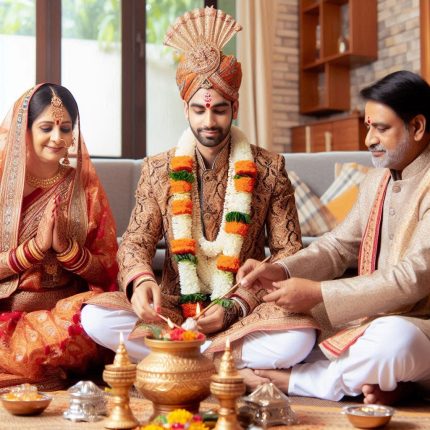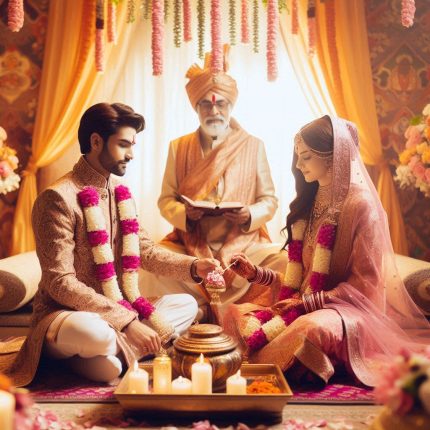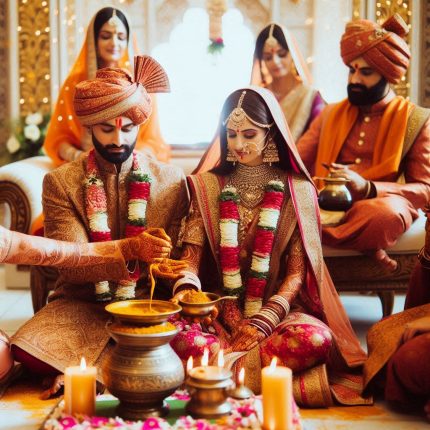Engagement Puja: Celebrating the Promise of Union
Samagri
for Puja:
Haldi [organic] (20gm), Kumkum [organic] (20gm), Tulsi Mala (1), Diya Batti (5), Beetle Nuts (5), Desi Ghee (20ml), Honey (20ml), Jaggery (Gudh) (20gm), Akshata [Yellow rice] (20gm), Yagno-paveetha (5), Karpoora [camphor] (5Tabs), Red/White/Yellow Cloth(1 mtr), Prasad [Laung, Elaichi, Mishri] (20gm), Mouli (25mtr), Ganga Jal (15ml), Durva [fresh] (1), Agarbatti (6)/Dhoop (2), Dakshina (100INR), God Idols (pair), Sambrani (2), Sambrani Holder (1), Kalash [small copper] (1), Panchpatra [small copper] (1), Diya Holder (2), Panchamrit spoon (1), Karpoora Holder(1), includes perishables [Beetle Leaves [fresh] (9), Flowers [fresh] (incl mala), Tulsi [fresh], Mango Leaves [fresh] (7)]
Small Havan:
Cow Dung Cake (2), Mango Wood (250gm), HavanSamagri [20+ Grganic Herbs] (100gm), Ghee (20ml)
Yajman to provide:
Curd (100gm), Milk (100ml), Mithai (250gm), Fruits [5types], Coconut (1), HavanKund, SuchiSarva (Havan Spoon) (1), Kalash [big] (1), Bowl [preferably copper/silver] (1), Spoon [preferably copper/silver] (1), Utensils [2 big Plates (for Aarti/Samagri), disposable Plates, Bowls & Spoons], First solid food (preferably Kheer or Payasam)
Introduction
An engagement marks the beginning of a new chapter in life, symbolizing the commitment to marry and build a future together. Known as a betrothal or pre-wedding ritual, the Engagement Ceremony is a joyful occasion where two individuals and their families come together to celebrate this significant promise. The Engagement Puja is a sacred ritual performed to invoke divine blessings and ensure a harmonious and prosperous future for the couple. This ceremony not only signifies the couple’s commitment but also garners the blessings of the gods for a joyful marital life ahead.
Importance and Significance of Engagement Puja
The Engagement Puja is an essential ritual that formalizes the union of two individuals and their families. It serves multiple purposes:
- Divine Blessings: The puja seeks the blessings of the deities to ensure a smooth and joyous journey towards marriage. It invokes divine grace for a happy and fulfilling life together.
- Cultural Tradition: This ceremony adheres to cultural traditions and practices, reaffirming the commitment to family values and customs.
- Family Bonding: The puja strengthens the bond between the two families, creating a foundation of trust and mutual respect.
- Astrological Considerations: The puja often involves checking astrological compatibility and performing rituals to harmonize planetary influences on the couple’s future.
Benefits of Engagement Puja
Performing an Engagement Puja offers several benefits:
- Harmonious Relationship: The puja helps establish a strong and harmonious foundation for the couple’s relationship.
- Divine Protection: It seeks divine protection and blessings for a smooth transition from engagement to marriage.
- Peace and Prosperity: The puja aims to bring peace, happiness, and prosperity to the couple and their families.
- Cultural Enrichment: Engaging in traditional practices enriches the cultural experience and maintains familial customs.
Occasions to Perform Engagement Puja
The Engagement Puja is held prior to the wedding ceremony. The timing can vary based on personal preferences and cultural practices:
- Before the Wedding: The puja is typically conducted months or weeks before the wedding, setting the stage for the upcoming nuptials.
- Same Day as Wedding Ceremony: In some communities, the Engagement Puja may take place on the same day as the wedding, just a few hours before the actual marriage ceremony.
Engagement Puja Vidhi (Procedure)
The Engagement Puja involves several key steps, ensuring that all traditions and rituals are observed:
- Preparation: The bride’s family presents gifts and traditional items to the groom’s family. The groom’s family reciprocates with gifts for the bride, including attire and accessories.
- Dressing Up: The bride dons the new attire and accessories provided by the groom’s family.
- Ceremonial Setup: The puja is conducted in the presence of the couple, their families, and a pandit (priest) who leads the rituals.
- Formal Proposal: The groom and his family formally seek the bride’s hand from her father, who then accepts the proposal.
- Divine Invocation: The couple seeks blessings from deities to bless their union. This may include a Ganesh Puja to remove obstacles and ensure a smooth path.
- Rituals: The feet of the bride and groom are washed as a sign of respect and purity. The groom’s side performs aarti for the bride, and auspicious items like coconut, haldi, kumkum, and akshata are placed in her lap.
- Exchange of Rings and Flowers: The couple exchanges rings and flowers, symbolizing their commitment and love.
- Seeking Blessings: The couple receives blessings from elders and family members.
- Formal Announcement: The pandit formally announces the engagement, and guests congratulate the couple and their families.
Engagement Puja Shubh Muhurat
The Shubh Muhurat (auspicious time) for the Engagement Puja is often determined based on astrological calculations and personal preferences. Choosing an auspicious time ensures that the ceremony aligns with favourable planetary positions, enhancing the positive effects of the ritual.
Conclusion
The Engagement Puja is a cherished tradition that celebrates the promise of marriage and seeks divine blessings for a prosperous future. It marks the beginning of a new journey for the couple and their families, fostering love, harmony, and joy as they prepare for their lifelong commitment. By participating in this sacred ritual, families honour their cultural heritage and embrace the blessings of the divine for a bright and happy future.


